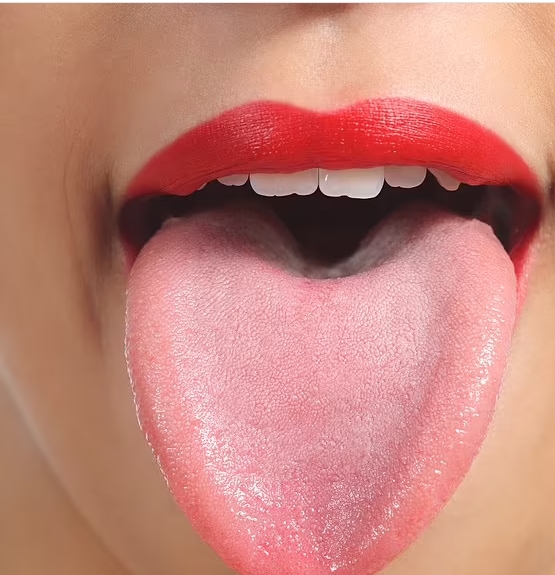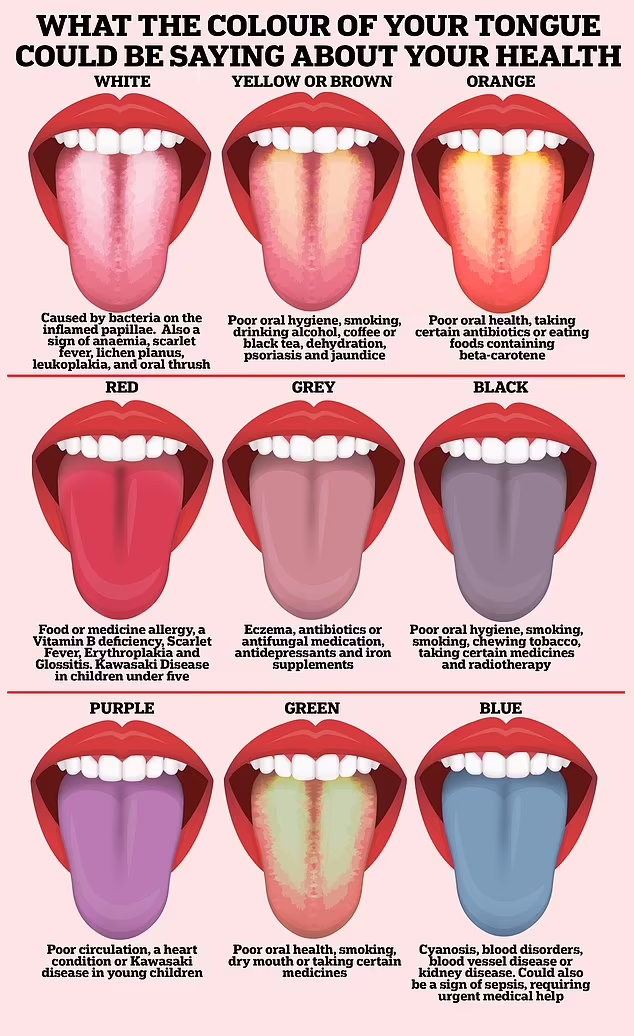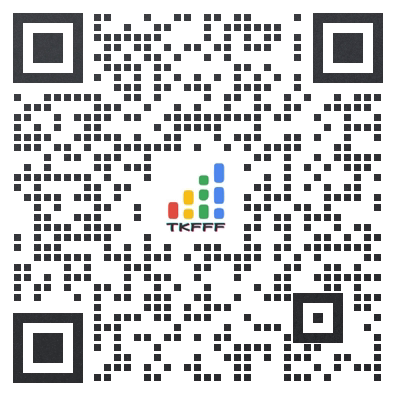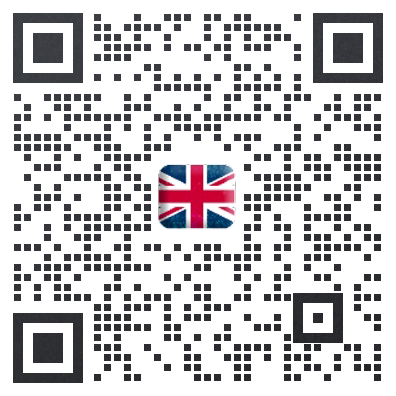After viral TikTok claims ‘cracks’ on the tongue means you shouldn’t drink coffee, we reveal the medical problems you can see by looking into the mouth
It is, if you believe what you see on TikTok, surprising ‘proof’ that you shouldn’t be drinking coffee: weird cracks appearing on the tongue.
In the clip, Dr Anis Khalaf, a proponent of traditional Chinese medicine from Florida, said this, along with a thick yellow coating on the tongue, was a sign of a ‘yin-deficiency’ in the body — an ‘insufficiency’ of bodily fluid.
And, under Chinese medicine, coffee is considered worsen this, interacting with people’s ‘fire element’, drying and warming the body.
As such the classic morning pick-me-up should be avoided by people low in yin, or so Dr Anis, who has almost half a million followers on the platform, claims.
These aspects of traditional Chinese medicine, as well as sections of the tongue being linked to certain organs, are on shaky scientific grounds, at least in Western medicine.

However, there are some changes to the tongue — and signs that you’re having too much coffee — that you should watch out for, according to experts.
White tongue
Having white tongue can be a sign of multiple conditions and while some are solely cosmetic others can indicate a medical problem that needs treating.
The first is anaemia, where the body isn’t producing enough red blood cells which can give the tongue a pale whitish appearance.
Another is lichen planus a rash on the tongue which experts believe is triggered by the body reacting to a viral infection or certain medications.
A similar looking condition, called leukoplakia, can represent abnormal growth in the tongue that can potentially progress to mouth cancer.
Whitish patches on the tongue that disappear when scrubbed can be an indicator of oral thrush, a fungal infection.
A white, or yellow, coating on the tongue can also be an early sign of the bacterial infection scarlet fever.
Finally, a condition called geographic tongue, which is an irregularity with how tongue tissue replaces itself, can cause white patches to appear.
The condition, which can run in families, is mostly harmless, but can cause some minor irritation.
Yellow or orange tongue
A yellow tongue is usually a sign to improve your oral hygiene as it’s caused by bacteria growing in minute traces of food left on the organ.
Being a smoker, as well as being dehydrated can increase the risk of this happening.
A yellow or white tongue can also be an early sign of scarlet fever and some parts of a geographic tongue can look yellow.
Jaundice, a sign that the liver isn’t working correctly, can turn your skin, eyes and tongue a yellowish shade.
Poor oral health, certain medications and eating too much foods rich in a natural orange compound called beta carotene, such as carrots, can also turn the tongue an orangish hue.

A healthy tongue should be pink, with small bumps – or papillae – across the surface. However, a range of other colours could be tell-tale signs a person is unwell
Red tongue
A bright red tongue can be a sign of various conditions.
Patches on the previously discussed, and mostly, harmless geographic tongue can be a noticeably reddish hue.
While the earliest signs of scarlet fever can include a whitish or yellowish tongue once the infection progresses the tongue turns red, swollen and develops bumps giving it the moniker ‘strawberry tongue’.
A red patch on the tongue can also be a sign of a condition called erythroplakia.
This is similar to the white patches leukoplakia in that it represents potentially abnormal cells that could go on to become cancer.
A red tongue can also be a sign of Kawasaki disease, which causes blood vessels to swell throughout the body, a rare condition that only effects one in every 25,000 children in the UK.
Having a red tongue can also be a sign of a folate deficiency as it leads the body to produce abnormally large red blood cells that cannot function properly.
Folate help keep the body’s nervous system properly and foods like meat, fish, eggs, dairy products as well as green vegetables are considered good dietary sources.
Grey tongue
Many of the same conditions that cause the tongue to turn a whitish colour can also make it look grey.
However, there are certain conditions that can make the organ turn grey specifically.
One of these is eczema with one study reporting people with the skin condition, which leads to dry and cracked skin due to a lack of moisture, are a risk of developing a greyish tongue.
Taking too many iron supplements, as well as a side effect of some medications, can also turn the tongue grey.
Black tongue
A condition called black hairy tongue, unsurprisingly, turns the tongue a dark hue.
While dramatic it’s not as harmful as it sounds. The condition is caused by dead cells building up on the papillae, the tiny bumps on the surface of the tongue.
This causes food and bacteria to get trapped giving the organ an alarming discolouration.
It is mainly triggered by poor oral hygiene though smoking and drinking alcohol can also contribute to it developing.
Purple tongue
A purple or bluish tongue can tongue can be a sign of poor circulation in the body.
Alongside a red tongue, some clinicians also consider a purple tongue to be a sign of Kawasaki disease.
Green tongue
Similar to yellow tongue, the appearance of a green tongue is the result of poor oral health, smoking, dry mouth or taking certain medicines.
Blue tongue
A blue tongue is widely considered to be a medical emergency as it is a sign the body is struggling to get enough oxygen.
It is typically accompanied by other signs such as the skin or lips also turning blue.
The lack of oxygen can be caused by numerous conditions including sepsis, heart failure or a dangerous blood clot.
People are advised to call 999 if they or someone they care for has their tongue, or other parts of their body, suddenly turn blue.

Have you ever wondered what exactly happens inside your body after taking that first sip
In his TikTok video, Dr Khalaf who has a degree in Oriental Medical Doctor and describes himself as a ‘candidate’ to become a doctor of medicine, advised people to check their tongue if they wondered if they should be drinking coffee.
‘If you have a lot of cracks in your tongue with a thick yellow coating, you probably shouldn’t be drinking coffee,’ he said.
Continuing to dish out advice to his 457,000 followers he added: ‘This is a yin deficiency with heat and dampness which basically means a fluid or cold deficiency with heat taking over.’
Dr Khalaf, who also advocates for the merits of homeopathy, an alternative medicine based on the power of dilution and for which there is no good evidence, has a disclaimer on his website on taking medical advice based on traditional medicine.
‘This content is for informational and educational purposes only. It is not intended to provide medical advice or to take the place of such advice or treatment from a personal physician,’ it reads.
‘All readers/viewers of this content are advised to consult their doctors or qualified health professionals regarding specific health questions.’
There are accepted signs that you may want to cut down on caffeine.
Dr Duane Mellor, a dietitian at Aston University said: ‘There are no reported oral side effects of excess coffee intake linked to caffeine.’
However, he added that known side effects from drinking too much coffee included ‘insomnia, irritability and anxiety in individuals who are susceptible as well as heart rate variability’.
Dr Mellor added: ‘Other side effects can include an upset stomach and change in bowel habit.’
NHS guidelines say around 400mg of caffeine a day is safe for adults, the equivalent of four regular cups.
Pregnant women are advised to consume around half that, while the recommended limit is around 100mg for teens.
文章来源:dailymail


TKFFF公众号
扫码关注领【TK运营地图】

TKFFF合作,请扫码联系!







 闽公网安备35021102002035号
闽公网安备35021102002035号